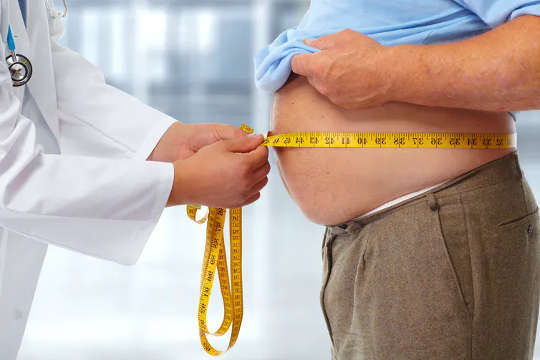
Lower fertility was linked to poorer health outcomes for both men and women. Pressmaster/ Shutterstock
Fertility has declined in most industrialised countries. While the causes are largely unknown, a number of factors may contribute to declining fertility rates, including the age a person starts a family, their diet, whether they smoke or drink alcohol, their weight, and whether they exercise. But whatever the causes, this decline in fertility means that about 15% of couples now take more than one year to conceive.
While much is still unknown about declines in fertility, our team wanted to understand the relationship between low fertility and health. We used time to pregnancy (the number of months it takes to conceive) as an indirect measure of fertility. We found that longer time to pregnancy was linked to more hospitalisations for both men and women and to shorter lifespan for women. This was particularly true when it took longer than 18 months to conceive.
To conduct our study, we used data on participants of two surveys of twins – totalling approximately 14,000 twins – born between 1931 and 1976. Around 55% of participants were women, while around 45% were men. We did not use these surveys because the participants were twins, but because they included detailed information on time to pregnancy for the first pregnancy attempt. Participants reported this information themselves during the interview for the survey.
In both surveys, the twins were 18 years or older and all those included had tried to become pregnant at the time of the survey. These studies were also linked to Danish national registries, which allowed us to access data on their hospitalisations and deaths from the time of the interview until 2018.
We found that, among this group, those that took longer to conceive, also had higher mortality, especially for women. Women who took 18 months or longer to conceive had an overall mortality around 46% higher compared with women who took less than two months to conceive.
Lower fertility was also apparently related to more hospitalisations. Women and men who took 18 months or more to conceive were hospitalised more often - around 21% more often for women and 16% for men - compared with those who took less than two months to conceive.
 Low fertility was linked to a wide range of diseases, including obesity. kurhan/ Shutterstock
Low fertility was linked to a wide range of diseases, including obesity. kurhan/ Shutterstock
Longer time to pregnancy was related to a wide range of diseases, especially in women, including nutritional and metabolic diseases (such as obesity or heart disease) and diseases of the respiratory organs (such as pneumonia). Time to pregnancy was also related to some causes of death, including from pneumonia and other respiratory diseases, and from digestive, urinary, genital, and endocrine diseases in women.
Environmental factors
Why does this apparent connection exist? The reasons for this association are largely unknown, but could be genetic, hormonal, lifestyle-related, or be due to in utero factors – for example, if a mother smoked while a child was in the womb.
In a previous study, using the same twin surveys, we tried to answer the question of whether time to pregnancy is genetic. In this study, the fact that the participants were twins was important. This is because monozygotic twins (coming from one fertilised egg cell) share all their genes, whereas dizygotic twins (coming from two fertilised eggs) share only 50% of their genes, like regular siblings. This means the genetic contribution to fertility can be observed.
We showed that most variation in time to pregnancy came from environmental effects, which accounted for around 96% of fertility in men and around 72% in women. But there was also a genetic effect, which accounted for 4% of fertility in men and 28% in women. Overall, this tells us that the environment plays a bigger role than genetics in fertility for both sexes, but there was a sizeable genetic contribution to fertility in women.
Putting the findings from both of our studies together, we can see that not only is lower fertility linked to poorer health outcomes, it is also determined largely by environmental factors like diet, whether a person smokes, and the age of which they first try to conceive.
The stronger link between low fertility and higher rates of hospitalisations and premature death in women is not entirely unexpected, as pregnancy certainly places higher demands on the female body than on men. However, future studies may want to directly compare differences in fertility between men and women.
Environmental factors may be modifiable. While more research needs to be done to better understand which specific factors lead to diminished fertility in men and women, our findings may point toward yet another reason to try to live a healthy life.![]()
About The Authors
Linda Juel Ahrenfeldt, Associate Professor, University of Southern Denmark and Maarten Wensink, Associate Professor, Epidemiology, Biostatistics and Biodemography, University of Southern Denmark
Related Books:
The Body Keeps the Score: Brain Mind and Body in the Healing of Trauma
by Bessel van der Kolk
This book explores the connections between trauma and physical and mental health, offering insights and strategies for healing and recovery.
Click for more info or to order
Breath: The New Science of a Lost Art
by James Nestor
This book explores the science and practice of breathing, offering insights and techniques for improving physical and mental health.
Click for more info or to order
The Plant Paradox: The Hidden Dangers in "Healthy" Foods That Cause Disease and Weight Gain
by Steven R. Gundry
This book explores the links between diet, health, and disease, offering insights and strategies for improving overall health and wellness.
Click for more info or to order
The Immunity Code: The New Paradigm for Real Health and Radical Anti-Aging
by Joel Greene
This book offers a new perspective on health and immunity, drawing on principles of epigenetics and offering insights and strategies for optimizing health and aging.
Click for more info or to order
The Complete Guide to Fasting: Heal Your Body Through Intermittent, Alternate-Day, and Extended Fasting
by Dr. Jason Fung and Jimmy Moore
This book explores the science and practice of fasting offering insights and strategies for improving overall health and wellness.
Click for more info or to order
This article is republished from The Conversation under a Creative Commons license. Read the original article.
























